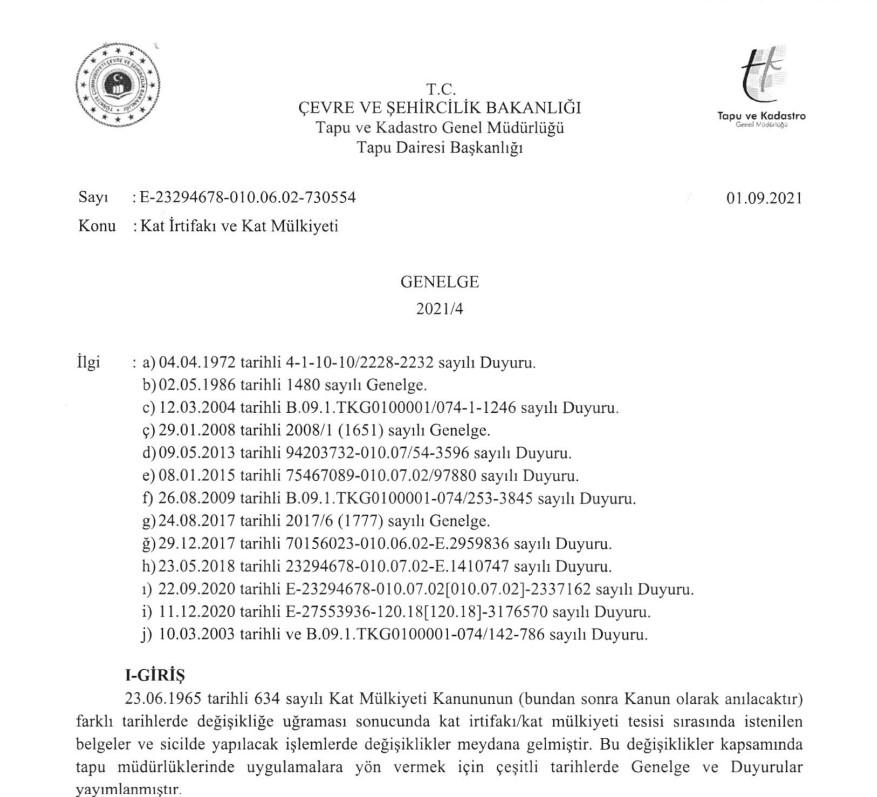As a result of the amendments to the Condominium Act No. 634 of 23.06.1965, numbered 634 (hereinafter referred to as the Act), there have been changes on different dates in the documents required when establishing a condominium easement/condominium title and in the transactions to be carried out at the Registry. As part of these changes, circulars and announcements have been issued on different dates to guide practice in Land Registry offices.
This circular is intended to clarify the procedures for conducting title deed transactions arising from the Condominium Act at land registry offices in general.
II- CONDOMINIUM AND CONDOMINIUM RENTALS
(a) Independent section
An independent section is a part of the main immovable property which is registered in the land registry as a separate immovable property suitable for independent use and is subject to independent possession. The law states that parts of a building, such as floors, flats, offices, shops, shops, storage, basements, warehouses, etc., must be registered as separate parts if they are fit for separate use.
(b) Establishment of condominium easements and condominium ownership in collective buildings.
List of documents:
– The location of buildings, common areas and facilities, the manner and order of use of buildings, a site plan prepared in accordance with the architectural design of an approved building licence, so as to cover all plots or parcels within a collective building, in accordance with the provisions of the building plan and parcel plans and approved by the competent authority.
– An architectural design drawn up by an architect, signed by the property owner or co-owners, and approved by the competent authority.
– A unified management plan to identify the buildings and locations within the scope of the collective building.
– The draft building application is formalised in the approval process for architectural designs sent electronically to the Land Registry Office by municipalities and other relevant institutions under the relevant(g) general guidelines.
– The standards published by the Directorate General under (g) require a three-dimensional digital building model of the architectural project to be sent to the title office.
– In addition to the documents listed above, in the case of a condominium, a building licence approved and valid for a certain period of time (5 months) is required, and in the case of condominium ownership, a certificate of occupancy permit is required.
If the aforementioned documents are submitted in full, the Land Registry Office shall issue an official deed and register the condominium easement and condominium ownership in accordance with Article 4 of Chapter II of this General Regulation.
2 – Common areas in collective buildings and Tcscili (official registration)
Common areas in a collective building are regulated as follows in the Act;
(a) Plots or independent sections within a collective building may be allocated for common use and benefit of independent sections within the collective building.
In the declaration column of the plots or independent sections which are within the collective building and which are common use spaces allocated for the common use of all independent buildings, the island, plot and independent section numbers of other plots within the collective building shall be recorded.
The column of declarations of independent units sharing a common area shall include the numbers of the plot/ or independent units allocated as common area and the plot or independent units sharing the plot or independent and units.
(b) Common social and infrastructure facilities of more than one building within a collective building shall be deemed to be common space of the independent units to which they relate, regardless of the lot or structure on which they are located. The common area referred to herein may be a landing area for condominium owners in all lots, condominium owners in a single lot, or condominium owners in a single unit within a collective building. This situation must be clear from the site plan, management plan or building design. Otherwise, if no such division has been made in the common areas, they are considered common areas of all independent units in the collective building, and condominium owners have ownership rights here in proportion to their land shares. Changes to the common areas are only possible with a unanimous vote of the condominium owners.






